Important Advice to Prevent Frozen Pipes in Winter
Important Advice to Prevent Frozen Pipes in Winter
Blog Article
This post further down pertaining to How to prepare your home plumbing for winter weather is highly motivating. Don't overlook it.

Cold weather can damage your pipes, specifically by freezing pipelines. Below's just how to avoid it from happening and what to do if it does.
Introduction
As temperature levels decline, the threat of frozen pipelines increases, possibly resulting in pricey repairs and water damages. Recognizing just how to avoid frozen pipes is critical for home owners in chilly climates.
Recognizing Icy Pipes
What triggers pipelines to freeze?
Pipelines ice up when exposed to temperatures listed below 32 ° F (0 ° C) for prolonged durations. As water inside the pipes freezes, it expands, putting pressure on the pipeline walls and potentially creating them to rupture.
Dangers and damages
Icy pipelines can lead to supply of water disruptions, residential or commercial property damages, and pricey repair services. Ruptured pipes can flood homes and trigger substantial structural damage.
Signs of Frozen Water Lines
Identifying frozen pipelines early can prevent them from rupturing.
Just how to determine frozen pipelines
Try to find decreased water circulation from faucets, uncommon odors or noises from pipes, and visible frost on exposed pipes.
Prevention Tips
Protecting vulnerable pipelines
Wrap pipes in insulation sleeves or utilize warm tape to shield them from freezing temperature levels. Concentrate on pipelines in unheated or exterior locations of the home.
Home heating methods
Keep interior spaces effectively warmed, especially areas with plumbing. Open closet doors to enable cozy air to distribute around pipes under sinks.
Shielding Outdoor Plumbing
Garden tubes and outside taps
Separate and drain pipes yard tubes before wintertime. Mount frost-proof faucets or cover outside faucets with shielded caps.
What to Do If Your Pipelines Freeze
Immediate activities to take
If you believe frozen pipelines, keep taps available to eliminate pressure as the ice melts. Use a hairdryer or towels taken in warm water to thaw pipes gradually.
Long-Term Solutions
Structural changes
Take into consideration rerouting pipes away from exterior wall surfaces or unheated areas. Add extra insulation to attic rooms, basements, and crawl spaces.
Updating insulation
Buy high-quality insulation for pipelines, attic rooms, and walls. Proper insulation assists preserve regular temperature levels and lowers the danger of frozen pipes.
Final thought
Stopping icy pipes requires proactive actions and fast actions. By understanding the causes, indicators, and safety nets, homeowners can secure their pipes during cold weather.
5 Ways to Prevent Frozen Pipes
Drain Outdoor Faucets and Disconnect Hoses
First, close the shut-off valve that controls the flow of water in the pipe to your outdoor faucet. Then, head outside to disconnect and drain your hose and open the outdoor faucet to allow the water to completely drain out of the line. Turn off the faucet when done. Finally, head back to the shut-off valve and drain the remaining water inside the pipe into a bucket or container. Additionally, if you have a home irrigation system, you should consider hiring an expert to clear the system of water each year.
Insulate Pipes
One of the best and most cost-effective methods for preventing frozen water pipes is to wrap your pipes with insulation. This is especially important for areas in your home that aren’t exposed to heat, such as an attic. We suggest using foam sleeves, which can typically be found at your local hardware store.
Keep Heat Running at 65
Your pipes are located inside your walls, and the temperature there is much colder than the rest of the house. To prevent your pipes from freezing, The Insurance Information Institute suggests that you keep your home heated to at least 65 degrees, even when traveling. You may want to invest in smart devices that can keep an eye on the temperature in your home while you’re away.
Leave Water Dripping
Moving water — even a small trickle — can prevent ice from forming inside your pipes. When freezing temps are imminent, start a drip of water from all faucets that serve exposed pipes. Leaving a few faucets running will also help relieve pressure inside the pipes and help prevent a rupture if the water inside freezes.
Open Cupboard Doors
Warm your kitchen and bathroom pipes by opening cupboards and vanities. You should also leave your interior doors ajar to help warm air circulate evenly throughout your home.

As an avid reader on Helpful Tips to Prevent Frozen Pipes this Winter, I figured sharing that piece of content was a good thing. Please pause to promote this entry if you liked it. We recognize the value of reading our article about How to prepare your home plumbing for winter weather.
Click Here Report this page